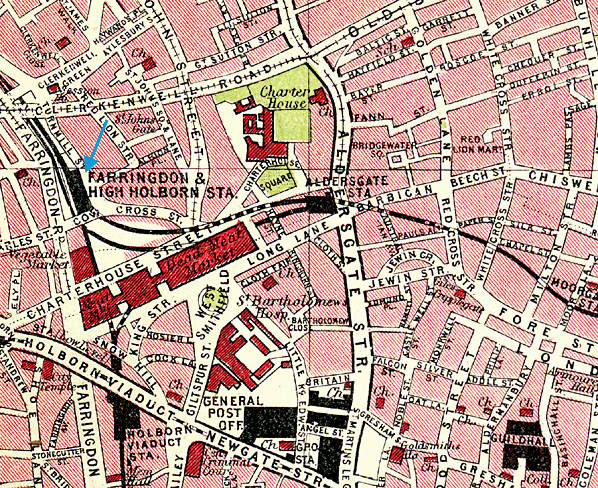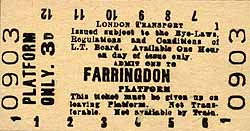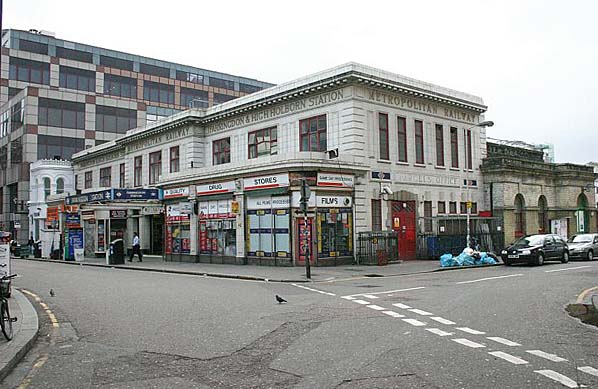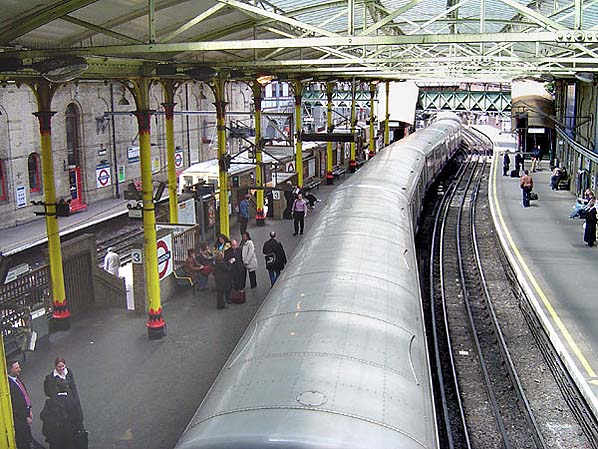
Station Name: FARRINGDON
|
| Date opened: | 10.1.1863 |
| Location: | On the north side of Cowcross Street |
| Company on opening: | Metropolitan Railway |
| Date closed to passengers: | Still open |
| Date closed completely: | Still open |
| Company on closing: | Still open |
| Present state: | Still open |
| County: | London |
| OS Grid Ref: | TQ316818 |
| Date of visit: | December 1980 |
|
Notes: Farringdon Station is on the Metropolitan, Hammersmith & City and Circle lines, between King's Cross St. Pancras and Barbican. The station also serves Thameslink trains which run from Brighton to Bedford. The station was opened on 10 January 1863 as the terminus of
the original Metropolitan Railway. The station, initially named
Farringdon Street, was originally located a short distance from
the present site. The line ran from Farringdon to Paddington,
a distance of 6 km. The station was relocated on 23 December
1865 when the Metropolitan Railway opened an extension to Moorgate.
The old station didn't close until 1.3.1866. It was renamed
Farringdon and High Holborn on 26 January 1922, and its present
name on 21 April 1936. The 'City Line' was far more than the Chatham could cope with financially, but the possibilities for through traffic were vast. To the north the G N R and the Midland could be reached and to the south were the L B S C R and L S W R at Clapham Junction from where the G W R and L N W R could be reached via the West London Line. All these companies were approached to partake financially and all eventually profited from the scheme gaining the right to work trains to their own goods and coal depots in South London. The line from Herne Hill to the Elephant and Castle was opened on 6 October 1862 and on to Blackfriars Bridge on 1 June 1864. Intermediate stations were initially provided at Camberwell, Walworth Road and Borough Road and later at Loughborough Junction. The Thames was eventually bridged and by 21 December 1864 a temporary station at Ludgate Hill was in use, a permanent station being opened on 1st June 1865. It had two narrow island platforms but the station was rebuilt in 1910 with a single broader island platform. On 1st January 1866, L C D R passenger trains began running into the Metropolitan's Farringdon Street station and the connection was soon carrying a wide variety of passenger and freight services. Then, by an Act of 13 July 1871, the Chatham became committed to yet another project. A nominally independent Holborn Viaduct Station Company (for the bankrupt Chatham was not allowed to raise capital) was authorized to build a 292 yard branch from the Ludgate - Farringdon line to a new terminus, complete with hotel, fronting on the new thoroughfare of Holborn Viaduct. It was opened on 2nd March 1874. On 1st August 1874 a low-level station, Snow Hill ('Holborn Viaduct Low Level' from 1912), was opened at the foot of the 1 in 39 incline. Finally, on 10th May 1886 a parallel bridge across the Thames was opened with, at the northern end, yet another new station, St. Paul's, the original Blackfriars Bridge being closed. St. Paul's was renamed Blackfriars on 1st February 1937. The existing layout was completed when the South Eastern Railway opened the Union Street spur on 1st June 1878 creating a through route into Charing Cross. The difficulties of inter-terminal transfer through the congested streets of mid-Victorian London assured considerable transfer traffic. All L C D R mainline trains, including continental ones, carried a City portion attached or detached at Herne Hill. Eventually however the development of the underground network led to the withdrawal of the through services and the demise in the importance of Holborn and Blackfriars with a dramatic reduction in off peak services. Holborn retained very heavy parcels traffic, including continental and three of its six platforms, too short for electric trains were utilised. The first casualty on the line was Borough Road which closed on 1st April 1907 due to competition from the Northern Line. As an economy measure during WW1 through services from south of the Thames to Moorgate via the Smithfield Curve (opened 1.9.1871) were withdrawn on 1st April 1916 with Camberwell and Walworth Road stations closing two days later. Holborn Viaduct Low Level closed on 1st June 1916 and with it through passenger traffic on the City Line ceased.
In 1902, 19.2 million passengers used Holborn, Ludgate and St. Paul's. Use declined with the loss of the cross London traffic until electrification. The growth of L.C.C. estates in S E London and Kent increased traffic but this was not maintained and in 1960 they were back to the 1902 level with 88% of the traffic arriving or departing during the rush hour. The 'City Line' was still a vital north-south freight link with some 90 trains a day in 1962, but all regular freight and parcels services were withdrawn in 1969. Although disused for many years the Snow Hill tunnel was finally abandoned in 1971 and the track was lifted. The Snow Hill tunnel was reopened in 1988 as part of the new Thameslink network which came into service in May 1990, initially as part of British Rail but private since March 1997. To coincide with the opening of Thameslink, Holborn Viaduct Station was closed on 22nd January 1990. The line into Holborn Viaduct over Ludgate Hill was removed and a new line built that drops down steeply from Blackfriars station into a new station called City Thameslink (opened 29.5.1990) beneath the former Holborn Viaduct Station. The station was originally called St. Paul's Thameslink but was renamed in 1991 to avoid confusion from St. Paul's station on the Central line. The northern part of the Thameslink network replaced the 'Bedpan' service from Bedford to St. Pancras and uses the existing Midland Main Line. In the south there are two branches. The main route runs through London Bridge to East Croydon and Brighton while the second branch initially ran into Guildford via West Croydon but has now been rerouted through Mitcham to terminate at Sutton. Thameslink
has become a significant commuter route serving the airports
at Gatwick and Luton and carries around 40 million passenger
journeys on the system annually. Sources: A
regional history of the railways of Great Britain - Volume
3 Greater London by H P White. David & Charles 1963 &
1971 ISBN 0 7153 5337 3 Other web sites: Abandoned
Tube Stations - includes a cab ride from Farringdon - Blackfriars |
1.jpg)
Photo by Nick Catford

2.jpg)
Photo by Nick Catford

|
 Home Page
Home Page | Last updated: Thursday, 18-May-2017 11:51:17 CEST |
© 1998-2005 Disused Stations
|


